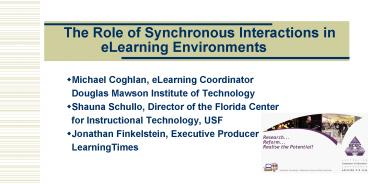The Role of Synchronous Interactions in eLearning Environments - PowerPoint PPT Presentation
1 / 25
Title:
The Role of Synchronous Interactions in eLearning Environments
Description:
(results at http://users.chariot.net.au/~michaelc/synch/surv_results.htm) The Trade-Offs (2) ... http://users.chariot.net.au/~michaelc/synch/surv_discuss.htm ... – PowerPoint PPT presentation
Number of Views:44
Avg rating:3.0/5.0
Title: The Role of Synchronous Interactions in eLearning Environments
1
The Role of Synchronous Interactions in
eLearning Environments
- Michael Coghlan, eLearning Coordinator
- Douglas Mawson Institute of Technology
- Shauna Schullo, Director of the Florida Center
- for Instructional Technology, USF
- Jonathan Finkelstein, Executive Producer
- LearningTimes
2
Tools for Synchronous Interaction
- Instant messengers (voice/text)
- Chat (voice/text)
- Peer to Peer/Collaborative Tools eg Groove, Mind
Mapping - Virtual Classrooms
3
How did I get here?
- 2003 research into the use of online voice tools
- Why research something that is not the solution
to anyones problem? Everyone is happy using
asynchronous methods. (April, 2003) - --------------------------------------------------
------- - Rena Palloff growth of synchronous interactions
would be a significant elearning trend in 2004
4
The Trade-Offs?
- Technology what tools are needed? Who controls
them? - Methodology the instructional challenge
- Flexibility is this what people want?
- Cost is this going to cost more?
5
The Trade-Offs (1)
- Technology
ca 1998
2004
- Delivery Method LMS
- safe
- secure
- centralised
- Delivery Method LMS
- disruptive technologies
- less secure
- greater bandwidth
- attracts mavericks
6
(The Firewall Divide)
INSTITUTI
THE INTERNET
THE FUTURE
THE INSTITUTION
synchronous delivery
asynchronous delivery
firewall
webcasting virtual classrooms
LMS
peer-2-peer application sharing
centralised IT control
7
Quiz Question 1
- Have you experienced the use of synchronous tools
in online courses that you have either taught or
studied?
8
Use of Synchronous Tools Survey (1)
- Random sample of 82 respondents
- Previous Experience
- 85 of respondents experienced use of synchronous
tools in online courses they had either taught or
studied - 37 used them regularly.
- (results at http//users.chariot.net.au/michaelc/
synch/surv_results.htm)
9
Quiz Question 2
- How have synchronous tools been used in
courses you have either taught or studied? - small group work?
- one-on-one communications?
- whole class meetings?
- whole class instruction?
- other?
10
Use of Synchronous Tools Survey (2)
- Purpose of Interactions
- 58 small group work
- 37 one-on-one communications
- 35 whole class meetings
- 16 whole class instruction
- (results at http//users.chariot.net.au/michaelc/
synch/surv_results.htm)
11
Innovative Use of Synch Tools
- Jonathan Finkelstein
- (LearningTimes)
- learningtimes.org
12
Quiz Question 3
- Would you recommend that synchronous interaction
be part of online courses?
13
Use of Synchronous Tools Survey (3)
- How Important?
- 91 deemed synchronous interaction in online
courses to be important - an emphatic 99 of respondents recommend that
synchronous interaction be part of online courses
- (results at http//users.chariot.net.au/michaelc/
synch/surv_results.htm)
14
Whats the Big Deal About Synch?
- What can be done in synchronous mode that can't
be done using asynchronous approaches? How do
synchronous interactions improve delivery?
Shauna Schullo University of South Florida
15
Quiz Question 4
- Why do you think it is important to include
synchronous tools in online courses?
16
Use of Synchronous Tools Survey (4)
- Why are synchronous tools important?
- Approx 50/50 split between pedagogical and
social/affective reasons - Pedagogy immediacy of feedback (30)
- (results at http//users.chariot.net.au/michaelc/
synch/surv_results.htm)
17
Social/Affective Benefits
- Social, community, and personal engagement
- personal engagement/motivation (55)
- community building (29)
- improving the social experience (27)
- (results at http//users.chariot.net.au/michaelc/
synch/surv_results.htm)
18
The Trade-Offs (2)
- Methodology
ca 1998
2004
- Asynch synch
- Content process
- Process Collaboration
- community
- Asynchronous
- Content focused
Risk synch can be predominantly teacher-centred
19
The Trade-Offs (3)
- Flexibility
ca 1998
2004
Committed to being online at a particular time
Anytime Anyplace
20
Tension Synch v Asynch
- Terry Anderson, Toward a Theory of Online
Learning - it may be more challenging than we think to
create and sustain (online) communities, and the
differenceslinked to a lack of placedness and
synchronicity, that is, mutual presence in time
and placemay be more fundamental than the mere
absence of body language and social presence.
21
Tension Synch v Asynch
- .the major motivation for enrollment in
distance education is not physical access, but
rather, temporal freedom to move through a course
of studies at a pace of the students choice.
Participation in a community of learners almost
inevitably places constraints on this
independence. - The demands of a learning-centered context
might at times force us to modify the
prescriptive participation in communities of
learning, even though we might have evidence that
such participation will further advance knowledge
creation and attention.
22
Resolving the tension between asynchronous and
synchronous approaches
- dont make synch sessions compulsory use synch
for those who want it - use a tool that can record or archive the
sessions for later retrieval (eg Elluminate,
Talking Communities) - dont use synchronous for whole class instruction
- use for meetings, one-on-one, or in small groups
- offer informal (social) sessions in synch mode
- allow student use of synchronous space
- offer office hours sessions at set times
23
The Trade-Offs (4)
- Cost
ca 1998
2004
- LMS
- Instant Messengers
- Virtual classrooms
- Collaborative tools
LMS Houses all content and communications
Annual cost of virtual classrooms can be as much
as a Blackboard or WebCT license
24
References
- Anderson, Terry Elloumi, Fathi Theory and
Practice of Online Learning (April 2004) - http//cde.athabascau.ca/online_book/
- Coghlan, Michael How important are synchronous
tools in web-based teaching and learning
environments? http//users.chariot.net.au/michael
c/synch/surv_discuss.htm - Muirhead, Brent Research Insights into
Interactivity, International Journal of
Instructional Technology and Distance Learning ,
March 2004 - http//www.itdl.org/Journal/Mar_04/article0
5.htm - Schullo, Shauna Synchronous Distance Education
Support Systems, Why Does the University of South
Florida Need One? 2003 http//www.tltgroup.org/Co
mmunityConnectedness/SynchTools.htm
25
Contact Details
- Michael Coghlan
- http//users.chariot.net.au/michaelc/
- michaelc_at_chariot.net.au































